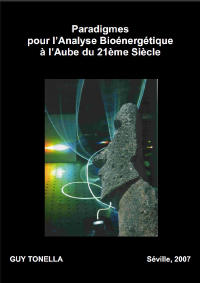Paradigms for Bioenergetic Analysis at the dawn of the 21st century
Guy TONELLA © CBT, France
Published in "Bioenergetic Analysis"*, Vol. 18, 2008, Ed. Psychosozial-Verlag, p. 27-59
*The clinical Journal of the International Institute of Bioenergetic Analysis (IIBA)
Keynote presented at the XIX° IIBA International Conference, Seville, Spain, May 2007

When he founded bioenergetic analysis half century ago, Alexander Lowen initiated a movement of a great amplitude. His personal charisma was an important factor. He also benefited from a vast sociological movement, in the Western hemisphere, that was seeking body experiences, expression and freedom. Back in those days, the hippie era was in full swing, all kinds of personal growth experiences were being made at "Esalen", the development of humanistic psychology, a "vitalistic" orientation in psychotherapy was picking up speed. Bioenergetic Analysis was moving at the same time towards international expansion. It was seen as a form of psychotherapy, but it was also considered to be a preventive approach and a way to foster healthy life habits, in particular through "bioenergetic exercises".
But what is happening today?
The "need for vitality" is still strong. But in our contemporary world, where brain imagery graphically reveals healthy vs. pathological processes, we, bioenergetic therapists, must demonstrate the relevance of our therapeutic practices. Lowen was not inclined to promote scientific research. He once wrote to me: "There is no need to justify: clinical proofs are enough". Often times, the perception people from outside have about Bioenergetic Analysis is a simplistic one: "crying, hitting, screaming".
We all know that Bioenergetic Analysis is much more than that and we must continue to build from the legacy of its creator:
- • we must modernize or actualize its basic concepts while taking into account the present state of scientific research in the fields of neurobiology and psychophysiology;
- we must integrate in our reflection the various developmental theories of the child and the adult that have been clinically and experimentally confirmed ;
- • We must take into account the evolution of psychopathologies and the necessary evolution of Bioenergetic Analysis methodologies: We must take into account the evolution of the needs of our populations with regards to public health, while knowing that sociological and geopolitical contexts marked by growing problems of violence and social inequities demand that we become creative, which may mean getting out of our offices. Our Brazilian members are proposing stimulating models with regards to that.
At the dawn of this 21st century, all of this demands of us that we stimulate an adjustment of our paradigms, a renewal of our Bioenergetic Analysis theoretical model. Our credibility, our "readability" (Note of the Translator: "readability" in the sense of "aptitude to be understood by others"), as well as our efficiency is on the line. But even more important than that, it is the very identity of Bioenergetic Analysis that is at stake, that on which we found our common identity, that which enables us to see ourselves as bioenergetic therapists and that which gives the International Institute for Bioenergetic Analysis a shared meaning.
Want to read more ? Download full article in PDF
